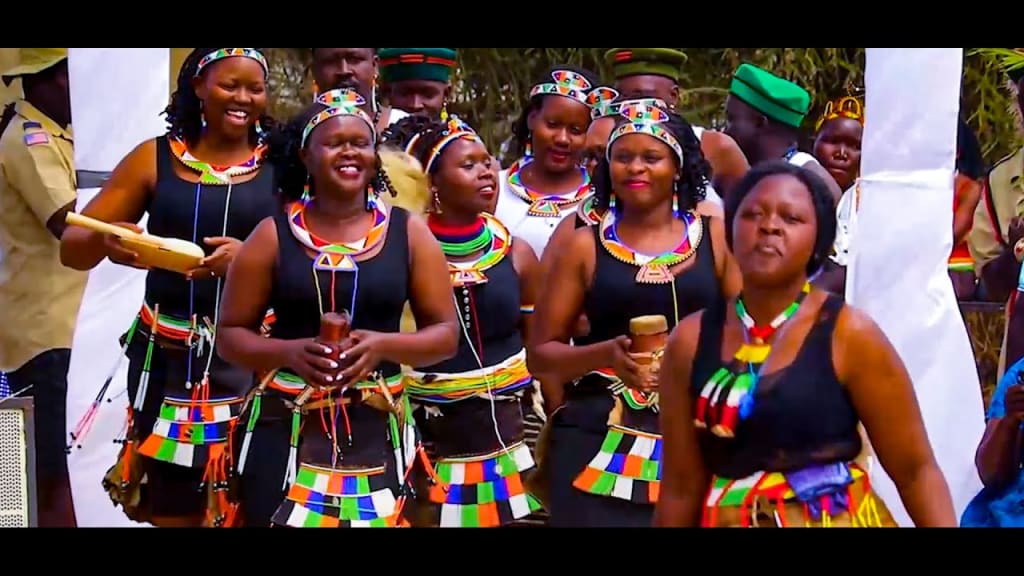THE KARAMOJONG PEOPLE OF UGANDA.
KARAMOJONG

The Karamojong People of Uganda .
Nestled in the northeastern region of Uganda, the Karamojong people stand as a testament to the resilience and vibrant cultural heritage of East Africa. This pastoral community has etched its identity against the backdrop of the Karamoja sub-region, weaving a tapestry of traditions that resonate through the ages.
The Karamojong are a Niletic ethnic group, primarily inhabiting the Karamoja sub-region, which spans the districts of Kotido, Kaabong, Abim, and Moroto. This semi-arid landscape, characterized by sweeping savannahs and rugged hills, has shaped the nomadic lifestyle that defines the Karamojong way of life.
Dress Code:
Traditional attire plays a pivotal role in expressing the cultural identity of the Karamojong. Men often adorn themselves with vibrant beads, animal skins, and feathers, creating a striking visual spectacle. Women, on the other hand, showcase their artistry through beadwork, adorned with intricate patterns and symbolic motifs.
Food:
The Karamojong people have a cuisine deeply rooted in their pastoral lifestyle. Milk and blood from their cattle are dietary staples, providing essential nutrients in the arid landscape. Meat, usually from goats and cows, is a significant part of their diet, often prepared through sun-drying or roasting over an open fire.
Nomadic Life:
Nomadism is intrinsic to the Karamojong lifestyle, as they traverse the vast landscapes in search of pasture for their livestock. This constant movement shapes their social structure, fostering a strong sense of communal bonds. The Karamojong people's nomadic life is a dance with nature, a harmonious coexistence with the land that sustains them.
Houses:
The traditional dwellings of the Karamojong are known as manyattas, circular huts made from a framework of wooden branches covered with a thatch of grass or reeds. These structures are designed to be easily dismantled and reconstructed as the community moves in search of grazing land for their livestock.
Ekipa Dance: The Heartbeat of Karamojong Culture
At the heart of Karamojong traditional dance is the Ekipa, a dynamic and rhythmic dance that transcends mere physical movements—it embodies the very essence of the Karamojong people. Ekipa is a communal celebration, a spirited expression that reflects the joys, challenges, and triumphs of the community.
Rhythmic Drumming:
The dance is accompanied by the rhythmic beat of traditional drums, setting the tempo for the intricate footwork and expressive movements of the dancers. The drumming not only serves as a musical accompaniment but also carries historical significance, recounting tales of the community's journey through time.
Symbolic Movements:
Ekipa is not just a display of physical prowess; it is a language of symbolism and storytelling. Each movement, from the stomping of feet to the waving of arms, carries deep cultural meaning. The dance often portrays scenes from daily life, such as hunting, herding, and communal celebrations.
Ceremonial Significance:
Ekipa is not confined to casual gatherings; it plays a central role in various ceremonies and rituals. From initiation rites to weddings and communal festivals, the dance serves as a powerful medium to connect the community with its cultural roots and spiritual heritage.
Community Bonding:
Participation in Ekipa is not limited by age or gender; it is a communal activity that fosters a sense of unity and belonging. Through the synchronized movements and shared expressions, the dance strengthens social bonds, reinforcing the interconnectedness of the Karamojong people.
Adornments and Attire:
Dancers often adorn themselves with traditional attire, including the vibrant beadwork and feathers that are emblematic of Karamojong culture. The visual spectacle created by the dancers' attire adds to the overall sensory experience of the dance, creating a captivating spectacle that engages both the participants and the audience.
Preserving Cultural Heritage:
In the face of modernization and external influences, the Ekipa dance stands as a powerful tool for preserving the cultural heritage of the Karamojong people. It is a living tradition passed down from one generation to the next, ensuring that the stories, values, and spirit of the community continue to thrive.
In essence, the Ekipa dance is not just a performance; it is a living, breathing embodiment of the Karamojong cultural identity. It is a celebration of resilience, a testament to the enduring spirit of a people who have danced through the challenges of time while staying rooted in their rich cultural traditions.
Interesting Facts:
Cattle Wealth: Cattle are not just a source of sustenance for the Karamojong; they symbolize wealth, status, and cultural significance. The more cattle a person owns, the higher their standing in the community.
Warrior Culture: The Karamojong have a rich warrior culture, with young men undergoing rigorous training to become protectors of their community. The warrior's role extends beyond defense, encompassing the responsibility of resolving conflicts and ensuring the well-being of the community.
Beadwork Symbolism: The intricate beadwork of the Karamojong is not just ornamental; it carries profound cultural significance. Different bead colors and patterns convey messages about age, marital status, and even social standing within the community.
Conclusion:
The Karamojong people stand as custodians of a cultural heritage that seamlessly blends tradition with the demands of their environment. Their nomadic lifestyle, vibrant attire, unique culinary practices, and close relationship with nature paint a captivating portrait of a community that thrives in harmony with the land they call home. The Karamojong are not just a people; they are a living testament to the resilience and richness of Uganda's cultural mosaic.





Comments (1)
please share your thoughts.